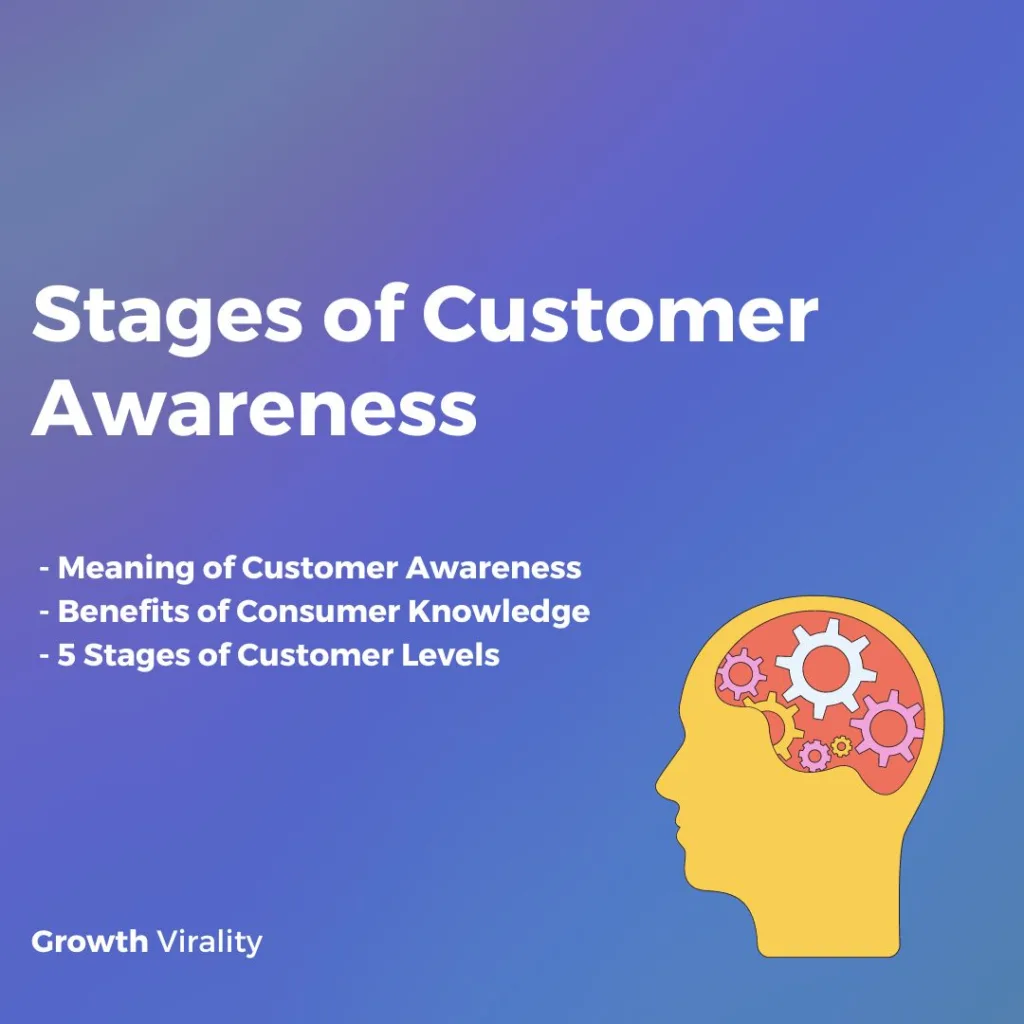The five stages of customer awareness levels is a copywriting framework that assists modern entrepreneurs and businesses reach and engage more prospects.
Crafting value-driven and intent-specific marketing creatives is an art that large enterprises have mastered by molding their messages to fit the customer’s awareness levels. Companies that prioritize customer experience increase their profits by 60%.
From sparking curiosity in those unaware of a problem to offering detailed comparisons for those ICP that are ready to purchase, these brands strategically design content that meets the customer right where they are.
By leveraging insights into customer awareness stages, they create ads, social media posts, and other marketing creatives that educate, engage, and guide potential buyers through decision-making, ultimately driving higher conversion rates and fostering brand loyalty.
As marketing expert Philip Kotler aptly said, “The best advertising is done by satisfied customers,” which starts with understanding and addressing their awareness journey.
Let’s understand the five stages of customer awareness to maximize resource efficiency and boost conversion rates, turning prospects into loyal advocates.
What is Customer Awareness?
Do you know about Coca-Cola, Starbucks, or Airbnb? I am sure you do because they have become proficient in customer attention.
Customer awareness occurs when your ideal customer persona is aware of your brand and the solution it offers.
Consumer awareness is the recognition that potential customers have about your business.
The consumer journey begins with customers not knowing they have a problem, progresses through discovering effective solutions, and continues buying a specific product or service to solve their pain.
Marketing strategist David Meerman Scott correctly says:
“Knowing the needs of your customers and your target market is the cornerstone of every successful business, whether it sells directly to individuals or other businesses.”
Understanding customer awareness allows brands to create the right story at each stage to increase the customer lifetime value.
5 Levels of Customer Awareness Explained
The five stages of customer awareness levels outline the journey from problem unawareness to product readiness, guiding effective marketing strategies at each step, leveraging the top customer segmentation tools.
Stage 1: Unaware [Consumers are not aware of their needs]
At this stage, potential customers are not aware of the problem or need that your product or service addresses, and they are also unaware of your brand and its offerings.
Why is it important? The unaware stage is important because it lays the foundation for customer awareness. Without understanding the problem or need, customers are unlikely to consider your product or service.
Questions to consider in the unaware stage:
- What challenges are your audiences currently facing in their work or daily life?
- How do they currently manage tasks or solve problems in their routine?
- Are there any areas where they feel they could save time or resources?
- What goals or improvements would they like to achieve personally or professionally?
- Are there any recurring problems that they think could be solved more effectively?
- How satisfied are they with your current process or solution for completing tasks or achieving goals?
- Have they considered the potential benefits of finding new solutions or improvements?
Creatives for this stage: Creatives for this stage should focus on highlighting the problem or need in a way that targets the customer’s pain points. They should create awareness and intrigue without explicitly promoting your product or service.
Examples of content pieces:
- Educational videos or articles highlighting common issues or challenges your product addresses without directly promoting the product.
- Visual representations of the problem or need can be compelling and easy to digest, sparking curiosity.
- Engaging in social media posts that pose questions or share statistics related to the problem can generate interest and awareness.
Stage 2: Problem Aware [Customers are beginning to learn more about their needs]
In the Problem Aware stage, your target buyers know their pain points. They recognize that there is an issue, and they need a solution for their issues.
Why is it important? This stage is critical because it signals that customers are beginning to learn more about potential solutions. You should prioritize STP marketing strategy at this stage.
Questions to consider in the problem stage:
- How are your target audiences currently dealing with their problems?
- Have they tried any solutions to address this problem? If so, what were they, and how effective were they?
- What prompted them to start looking for a solution to this problem?
- What outcomes or improvements are they hoping to achieve by solving this problem?
- Are there any specific features or capabilities they seek in a solution?
- How would solving this problem benefit you or your business?
- Have they considered any alternatives or competitors in their search for a solution?
- What obstacles or challenges do they foresee in solving this problem?
Creatives for this stage: Advertising materials should focus on the customer’s problem and highlight its potential negative impact. Design and copywriting should educate users and create a sense of urgency to find a quick solution.
Examples of content pieces:
- Problem-focused blog posts written by expert and experienced contributors with in-depth knowledge of the subject.
- Series of emails that educate about the problem and its consequences gradually lead to your solution’s introduction.
- Live sessions that discuss the problem in-depth and offer insights into potential solutions.
Stage 3: Solution Aware [Consumers are now considering
solutions for their needs]
Customers in this stage know that solutions exist for their problems or needs. They are researching and evaluating different options.
Why is it important? This stage is crucial because customers now consider specific solutions, including your product or service. It’s an opportunity to differentiate your offering and demonstrate its value by creating different growth marketing funnels.
Questions to consider in the solution-aware stage:
- How do your audiences envision a solution fitting into their current workflow or lifestyle?
- What outcomes or results are they hoping to achieve?
- What concerns do they have about potential solutions available in the market?
- How do they prefer to learn more about potential solutions?
- What factors will influence their decision when choosing a solution?
- Are there any specific brands or products they are already considering?
Creatives for this stage: Content and marketing graphics should highlight your product’s unique features, benefits, and advantages over competitors. 72% of consumers want to learn about products or services via video, so you should leverage digital channels and use personalized marketing to reach modern consumers.
Examples of content pieces:
- Detailed product comparison guides highlighting why yours is superior.
- Videos that showcase how your product works and how it solves the customer’s problem.
Stage 4: Product Aware [Customers make product comparisons and research]
At this stage, customers know your product or service and its features. They are considering it a potential solution to their problem and evaluating its suitability.
Why is it important? This stage is crucial as customers are close to making a purchase decision. 90% of consumers prefer to research more about products or services online before they contact the company. Addressing any remaining objections or doubts and highlighting the benefits of your product or service can help convert them into customers.
Questions to consider in the product awareness stage:
- What is your target customer’s budget for this purchase?
- How important is customer service or support to them?
- What kind of reviews or recommendations do they look for before purchasing?
- Are there any deal-breakers or must-have features for them?
- How soon do they plan to make a purchase decision?
Creatives for this stage: Advertising materials should contain your product or service’s unique value proposition, highlighting how it solves the customer’s problem better than competitors.
Examples of content pieces:
- Videos or interactive content demonstrating how your product works and its benefits.
- Real-life experiences from satisfied customers in the form of testimonials.
- Free trials or samples to experience your product firsthand increase their purchase likelihood.
Stage 5: Most Aware [Consumers are searching for the best deals to complete the purchase]
Customers in this stage are fully aware of your product or service, its features and benefits, and how it can solve their problems. You should now pull them towards a sale by offering them free trials, offers, and incentives.
Why is it important? This stage is super important because your potential customers are on the verge of purchasing. You should provide them with the right deals to help them convert and also focus on your north star metrics to achieve your growth goals.
Questions to consider in the most aware stage:
- Are there any influencers or experts in this field whose opinions your target customers value?
- How important is pricing in their decision-making process?
- Do they prefer to purchase products or services online, in-store, or through other channels?
- What are their primary considerations when comparing different products or services?
- Have they encountered any challenges or limitations with products or services they have used in the past that they hope to avoid this time?
Creatives for this stage: Marketing collateral should provide incentives to encourage immediate action, such as limited-time offers, discounts, or bonuses.
Examples of content pieces:
- Discounts and promotions to encourage immediate purchase.
- Client success stories to persuade the prospects towards the sale.
- Up-sell and cross-sell offers.
Why Are The Benefits of Customer Awareness
Knowledge of customer awareness offers the following advantages to businesses in optimizing their marketing strategies:
Increased Sales
Customers aware of a brand and its products are more likely to purchase.
Brand awareness helps consumers recognize and remember a brand’s logo, name, and products.
Establishing strong recognition is crucial for brands, as it builds trust and keeps the brand top of mind for potential customers.
Effective brand strategies target specific audiences, offer unique selling propositions, and maintain consistent messaging across all touchpoints, ultimately increasing sales.
Brand Loyalty
Awareness fosters trust and loyalty, leading to repeat business.
Brand loyalty is when customers choose your brand over others, often without thinking about it. This strong preference usually grows from positive experiences and trust built over time.
By understanding and nurturing consumer awareness at different stages, you can guide customers towards this loyalty, ensuring they repeatedly choose your products or services. This is the ultimate goal of brand-building efforts: turning satisfied customers into dedicated advocates.
Market Differentiation
81% of companies agree that customer awareness and experience are great competitive differentiators.
By understanding the different consumer awareness strategies and tactics and by using the top marketing communication tools, you can distinguish your brand from your business rivals by highlighting your unique selling points for more profits.
Customer Advocacy
Informed customers are likely to recommend products to others, enhancing word-of-mouth marketing.
Also, aware customers provide valuable feedback, helping improve products and services.
Reduced Marketing Costs
High customer awareness can reduce the need for extensive advertising efforts. Close to 60% of consumers have stated they would like to purchase from businesses they have heard about.
Better Customer Relationships
90% of customers rate “immediate” response as essential for customer service inquiries. You can build stronger customer relationships by informing your customers and offering them proactive solutions to their issues.
Frequently Asked Questions
What are the five levels of consumer awareness marketing?
Consumer awareness in marketing consists of five levels:
- Unawareness
- Awareness
- Solution aware
- Product aware
- Most aware
Who introduced the five stages of customer awareness?
Eugene Schwartz introduced the concept of the five stages of customer awareness in his book “Breakthrough Advertising.”
He outlined consumer awareness stages as a framework for understanding how customers perceive and interact with marketing messages.
What is the importance of using the five levels of customer awareness?
The five levels of customer awareness are super helpful in marketing.
Knowing these consumer awareness levels helps you prepare intent-focused messages that
speak directly to where your customers are in their journey, making your marketing creatives and messages more persuasive and relevant.

